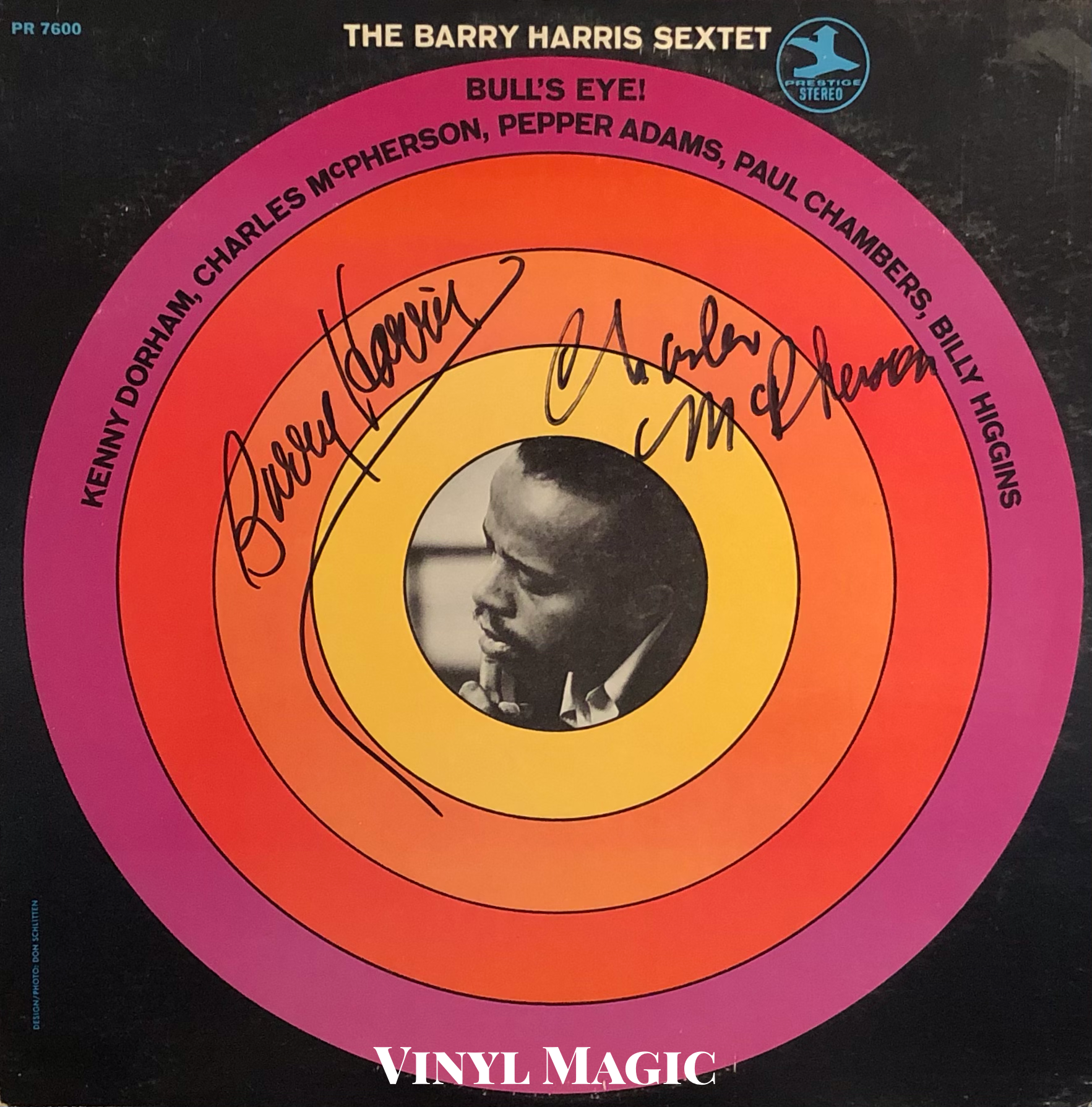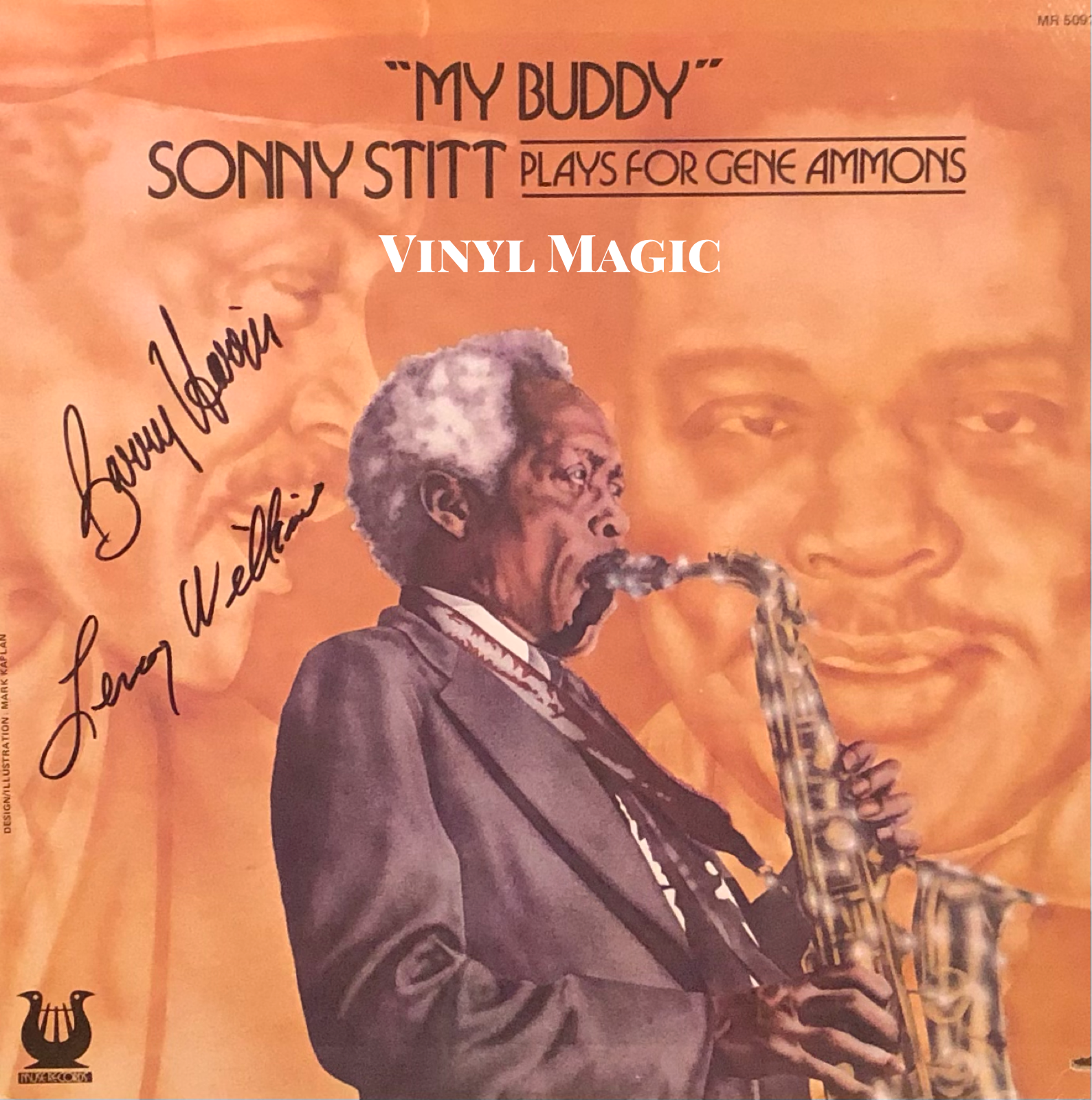Barry Harris and Me…
Most of us grew up playing in the church, where my mother started me. I studied classical with a preacher named Neptune Holloway, who quite a few of us took lessons from, and also Mrs. Lipscomb which was in a private home. Tommy Flanagan and I took lessons from Gladys Dillard; we were in a recital together one time. My mother was a very gentle and beautiful person, and one day she asked me whether I wanted to play church music or jazz. I said 'I'll play jazz,' and she was cool with that.
Barry Harris
Bull’s Eye (1968) signed by Barry, Charles McPherson
We played for our contemporaries. We played for shake dancers, we played shuffle rhythm, we played rhythm and blues. All of it was part of the deal. I would go to the dance, stand in back of the piano player and steal a couple of chords, then go home and learn how to play them. I remember Donald Byrd one day saying, 'I don't want to play in a bar, I don't want to play in a dance hall. I want to play on the concert stage.' Well, separating the music from dancing might have been the biggest drag that ever happened to us. We knew how to dance.
Barry Harris Downbeat interview 2000
Lee Morgan Memorial Album (1974) signed by Barry, Harold Mabern, Billy Harper
Barry always had a nice dynamic attack and approach to the piano. He was quick to get hip to Bud Powell, devoted more time to that style than anyone else on the scene then. He took it another step. He had a lot of confidence too. He was one of the few guys who would just wait for Charlie Parker to come to town and go up and sit in with him. That's more confidence than I had, I just didn't have the nerve.
pianist Tommy Flanagan
I Remember BeBop (1978) signed by Barry, Tommy Flanagan
I sat in with Bird at least three or four times. His band was late one time for a dance at the Graystone Ballroom, so we played just one song with him during the first set, a blues in C. He was beautiful to us. The best experience that I always tell people is a time he was playing a dance with strings at a roller rink called the Forest Club. We stood in front and the strings started, and when he started playing, chills started at your toes and went on through your body, orgasms, everything imaginable. It's really a spoiler. I don't like to go listen to people because I'm expecting somebody to make me feel like that. Bud Powell is important to me, I'm more of a Charlie Parker disciple, even more so now.
Barry Harris Downbeat interview 2000
Stay Right With It (1961/62 recordings, remastered/released 1978) signed by Barry, Charles McPherson
The great pianist Barry Harris passed away December 8, 2021. He was ninety-one years old and I wish peace and blessings to his family and friends. His performances, filled with elegance, lyricism and grace, were master classes by a master. This tribute was written five years ago after another riveting performance at the Village Vanguard…
Barry Harris is part of the great tradition of jazz artists from Detroit. Pianists Hank Jones, Tommy Flanagan, trumpeters Donald Byrd, Thad Jones, guitarist Kenny Burrell, drummers Elvin Jones, Louis Hayes and multi-instrumentalist Yusef Lateef are among Barry's Motown brethren who have had storied careers as musicians and composers. Initially, Barry honed his chops as the house pianist at the Blue Bird Inn (Thad Jones' composition "5021" refers to the actual address on Tireman) where he backed Sonny Stitt, Thad Jones and Miles Davis (for an extended three month stint in 1955 when Miles was trying to kick heroin), and at the Rouge Lounge where he accompanied Ben Webster, Lester Young and Lee Konitz. Eventually, Barry left Detroit to tour with Cannonball Adderley and he relocated to New York City in 1960 where he has remained ever since.
At The Jazz Workshop (1960) signed by Barry, Louis Hayes
Barry has released more than twenty-five albums as a leader, and he has appeared on hundreds as a sideman, including seminal and canonical recordings with Lee Morgan (The Sidewinder), Yusef Lateef (Eastern Sounds), Dexter Gordon (The Tower Of Power!) and Cannonball Adderley (Them Dirty Blues). Perhaps his greatest contribution has been his commitment to teaching. It started in Detroit and it has continued during his long stay in New York. A then fourteen year old Charles McPherson, a budding saxophonist, would practice at Barry's Detroit home and it blossomed into a sixty-five year personal and professional relationship.
Two Trumpets (1956) signed by Barry, Donald Byrd, Art Farmer, Jackie McLean
McPherson later explained, "He always leaned toward showing people things about harmony and theory, and his house was always a hub of activity. Musicians would come by and hang out with him. He had a reputation that extended not only to local musicians, but to musicians coming through town from New York. I saw everybody there, Sonny Rollins, Cannonball (Adderley). Trane came when I was there saying, 'OK Barry, what are you doing these days? What are you working on?' He's a master pianist, but it's more than knowledge that you can get from someone like Barry. You also get an element of musicality. You get the nuts and bolts, but you also get a sense of how to think about the aesthetics of music and art."
The Other Side Of Benny Golson (1958) signed by Barry, Benny Golson, Curtis Fuller
I saw Barry perform again recently at the Village Vanguard in New York City with bassist Ray Drummond and Leroy Williams, his drummer of choice for the past forty years. Opened in 1935 by proprietor Max Gordon as a folk, blues, and poetry space, the Village Vanguardhas become the most famous and revered jazz club in the world. It is a small space with seats for just 123 patrons in a basement off Seventh Avenue South. The acoustics are perfect and the venue has never been altered through the years. The blood red drapes hang heavy behind the small stage at the end of the room, enriched with the smoke and history of legendary performances past. Pictures of musicians line the walls, old lions like Thelonious Monk, Dexter Gordon, Charles Mingus, Bill Evans, and younger lions like Brad Mehldau and Wynton Marsalis, all artists who have recorded extensively here. In fact, there have been more than fifty live recordings issued and, as the late Bruce Lundvall, head of Blue Note Records observed, "The words 'Live At The Village Vanguard' do have a direct and positive influence on an album's sales." Indeed, it has an especially meaningful cachet among jazz aficionados.
Tower Of Power! (1969) signed by Barry, Buster Williams
The Friday night show at the Village Vanguard was sold out and the crowd was a bit raucous, fraught with the tension and anticipation of hearing a jazz lion in his lair. Barry did not disappoint. Although now eighty-six years old, you would never know it when Barry sat at the piano. His phrasing was challenging, lyrical, and swinging. Highlights were "Don't Blame Me", an alluring ballad off his 1960 vinyl At The Jazz Workshop, a bouncy "Isn't She Lovely?" from Stevie Wonder, an elegiac "Come Sunday" from the Duke Ellington songbook, a spritely "I Want To Be Happy", and a properly mournful "Lush Life" from the pen of Billy Strayhorn. It was an elegant performance of exquisite jazz piano.
Blues For Duke (1975) signed by Barry
Midway through the show, Barry announced, "Tonight, we're going to do something I'm sure you all expected to do at a jazz club. We're going to sing Karaoke! And we're going to write a song together." He continued amid the surprise and laughter, "I need some numbers. What are your favorite numbers 1 - 9?" Inwardly, I groaned, possibly my least favorite activity, an audience sing-a-along, and at the Village Vanguard?!. Numbers were quickly shouted by enthusiastic audience members and Barry said, "I heard 6, 7 and 3. I can make this work," and he began to play a greasy blues vamp and sang "6-7-3." Then he asked for participation and timidly, his Vanguard Choir barely mouthed "6-7-3" for three verses until he exhorted, "Come on now, you ain't ever getting into Heaven singing like that!" Suitably challenged, the audience responded with vigor and when we got to the bridge, Barry added "5-5-5-5." The song actually worked far better than I feared as I guess it helps to have a world class pianist and rhythm section! The closing song was Barry's theme, "Nascimento", a Latin rhythm written for an obscure percussionist whom Barry befriended during one of his trips to Brazil, not for noted Brazilian guitarist/songwriter Milton Nascimento as many assume.
Bottoms Up (1968) signed by Barry, Illinois Jacquet
After the show, I visited with Barry and he signed some albums. I greeted him with, "Stevie Wonder never sounded so swinging!" Barry said, "Oh thank you very much. I just had to do that song that way. That's a really fun song to play." It was certainly fun for the audience. When he saw the Sonny Stitt albums, Barry grew pensive. "You know, I sign these albums now, and I'm the only one who is still alive. It's just weird." Changing the topic, I offered, "You know, I love your version of "My Buddy", you do a really uptempo, swinging version. It's one of my favorite songs." "Thank you, that is a great song." He leaned over to his drummer, Leroy Williams who was seated next to him on the banquette, "Do you know that song?" Leroy nodded affirmatively. I couldn't resist, "You play it fast, but it's also beautiful as a ballad, 'Nights are long since you went away....' " Barry smiled at my attempt at the first stanza of the lyric, "Yes, I hope I don't go away any time soon!" Both Leroy and I assured him that was not going to happen, he had lots of new music to play. It was a lovely visit after a lovely night of music.
My Buddy (1976) signed by Barry, Leroy Williams
Pianist Duke Pearson wrote in the 1968 liner notes to Bull's Eye, "Going out to a club to hear Barry is just like a tonic. It restores your faith in beauty. Jazz should be beautiful and Barry's always is." Those words were true then and, almost fifty years later, those words seem truer now.
Barry Harris, a beautiful man with beautiful music.
Atlantic Jazz Piano (1986) signed by Barry, Dave Brubeck, Ray Bryant, Kenny Barron, Tommy Flanagan, Hank Jones, Sir Roland Hanna, Junior Mance, Brad Mehldau, Dwike Mitchell, Andre Previn, Horace Silver, Billy Taylor, McCoy Tyner, Chucho Valdes
Choice Barry Harris Cuts (per BK's request!)
https://www.youtube.com/watch?v=qJi03NqXfk8
"The Sidewinder" with Lee Morgan 1963
https://www.youtube.com/watch?v=elxQn503iTI
“Nascimento" First Time Ever 1997
https://www.youtube.com/watch?v=_YOPadEOCRg
“My Buddy" Sonny Stitt with Barry 1976
https://www.youtube.com/watch?v=kBpS9pyvUwo
"My Buddy" A different take by Jerry Jeff Walker 1975
https://www.youtube.com/watch?v=KFGuFfrpTVc
“Well You Needn't" Barry and Tommy Flanagan Play Thelonious Monk Live
https://www.youtube.com/watch?v=doJ8qS1XcaA
"Don't Blame Me" At The Jazz Workshop 1960
https://www.youtube.com/watch?v=u_sBbARz-M8
“Isn't She Lovely" Live 2015
https://www.youtube.com/watch?v=iZuCQFie-Ag
"A Time For Love" Live 2014
Atlantic Jazz Piano back cover signed by Monty Alexander, Roger Kellaway, Harold Mabern, Gonzalo Rubalcaba, Randy Weston












